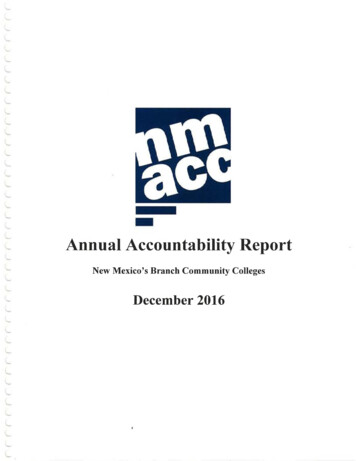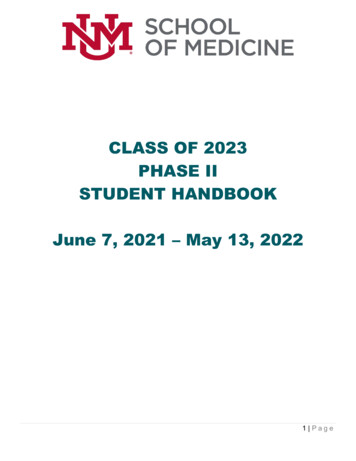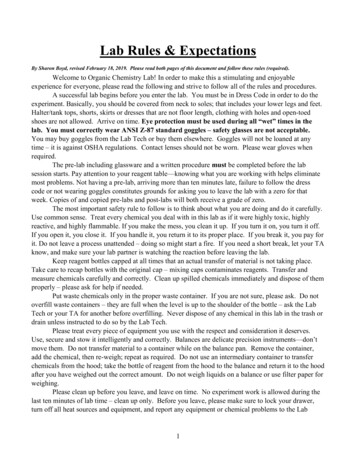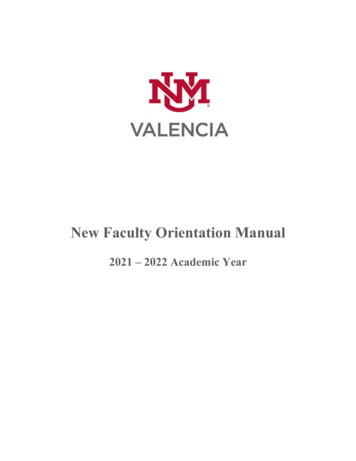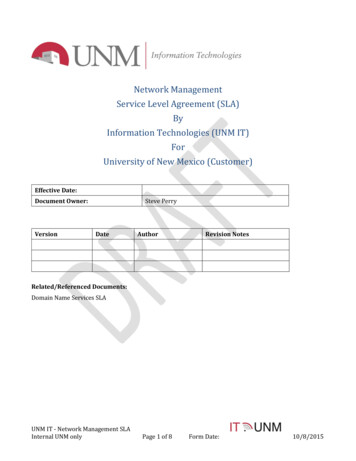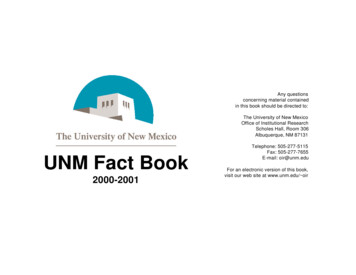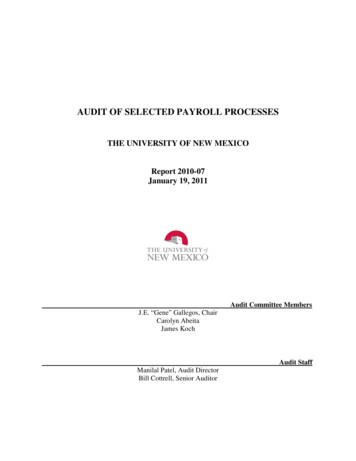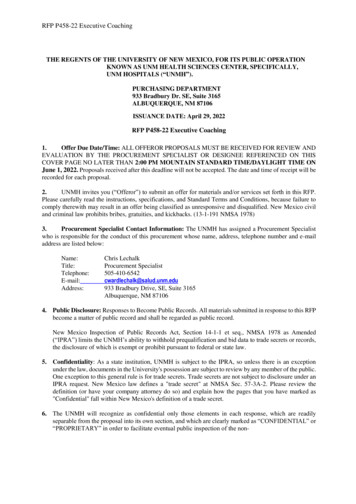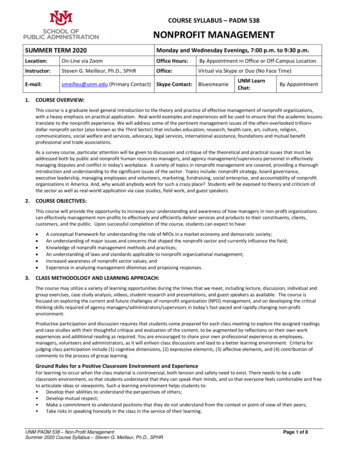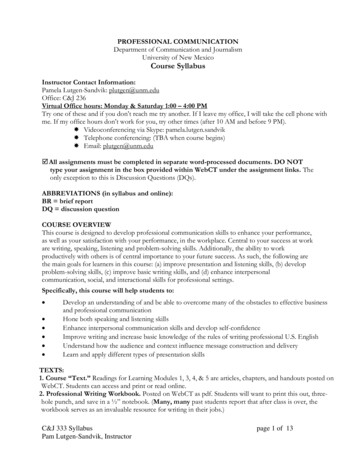
Transcription
PROFESSIONAL COMMUNICATIONDepartment of Communication and JournalismUniversity of New MexicoCourse SyllabusInstructor Contact Information:Pamela Lutgen-Sandvik: plutgen@unm.eduOffice: C&J 236Virtual Office hours: Monday & Saturday 1:00 – 4:00 PMTry one of these and if you don’t reach me try another. If I leave my office, I will take the cell phone withme. If my office hours don’t work for you, try other times (after 10 AM and before 9 PM). Videoconferencing via Skype: pamela.lutgen.sandvik Telephone conferencing: (TBA when course begins) Email: plutgen@unm.edu; All assignments must be completed in separate word-processed documents. DO NOTtype your assignment in the box provided within WebCT under the assignment links. Theonly exception to this is Discussion Questions (DQs).ABBREVIATIONS (in syllabus and online):BR brief reportDQ discussion questionCOURSE OVERVIEWThis course is designed to develop professional communication skills to enhance your performance,as well as your satisfaction with your performance, in the workplace. Central to your success at workare writing, speaking, listening and problem-solving skills. Additionally, the ability to workproductively with others is of central importance to your future success. As such, the following arethe main goals for learners in this course: (a) improve presentation and listening skills, (b) developproblem-solving skills, (c) improve basic writing skills, and (d) enhance interpersonalcommunication, social, and interactional skills for professional settings.Specifically, this course will help students to: Develop an understanding of and be able to overcome many of the obstacles to effective businessand professional communicationHone both speaking and listening skillsEnhance interpersonal communication skills and develop self-confidenceImprove writing and increase basic knowledge of the rules of writing professional U.S. EnglishUnderstand how the audience and context influence message construction and deliveryLearn and apply different types of presentation skillsTEXTS:1. Course “Text.” Readings for Learning Modules 1, 3, 4, & 5 are articles, chapters, and handouts posted onWebCT. Students can access and print or read online.2. Professional Writing Workbook. Posted on WebCT as pdf. Students will want to print this out, threehole punch, and save in a ½” notebook. (Many, many past students report that after class is over, theworkbook serves as an invaluable resource for writing in their jobs.)C&J 333 SyllabusPam Lutgen-Sandvik, Instructorpage 1 of 13
KEYS TO ONLINE COURSE SUCCESSTo be successful in this course, students will need to consider the following issues: Discipline. An Internet class requires the highest level of student responsibility anddiscipline. This means turning in assignments on time and keeping up with required reading. Ask Questions. Ask when material or assignment details are unclear. Do your part of thework (readings, check with syllabus, know assignment details) prior to asking questions. Callme for more input; I am very happy to speak with you and help any way I can. Structure. Students will be most successful if they follow the same sequence for eachlearning module: Reading, RAT, DQ/Assignment, Lectures. Stay Prepared. Do assignments including readings on time and prior to participation in DQs. Participate. Engage in the online discussions with your group and the instructor. Get toknow your group members. Contribute with respect and consideration for others. Display Respect and Appreciation for Difference. Honor all cultural backgrounds, withoutprejudices, biases, or preconceived beliefs and ideas. Keep an open mind with a positive,proactive, constructive attitude.GRADESPercentages: Final grades are based on the percentage of points earned.A: 90.0-100B: 80.0-89.9C: 70.0-79.9D: 60.0-69.9F: 59.9 & Grade Posting: Grades will be posted on the WebCT course supplemental site as soon as possibleafter assignment grading.Grade Descriptions: These are the criteria that determine earned grades on assignments. (Consultthese when considering a grade appeal.)A significantly exceeded basic criteria / distinguished for superior performance (free of errors, strongorganization & use of evidence)B exceeded basic criteria in some way / above average (few simplistic errors, organization & evidencecould be more clearly linked)C met basic criteria / average (frequent errors in spelling / grammar, unclear organization & evidenceuse)D failed to meet basic expectations (poor quality work, readability inhibited by the writing quality, use oftheory & evidence not clear)F incomplete work (disregard for assignment format / content, fraught with errors)Grade Appeals:1. Wait at least twenty-four hours2. Complete within 7 days of receiving disputed grade3. Review work, reread the grade descriptions on syllabus, reread assignment details, and reflecton instructor’s comments/earned grade4. With these in mind, submit appeal in writingC&J 333 SyllabusPam Lutgen-Sandvik, Instructorpage 2 of 13
5. Two key areas: (1st most important):a. substantive areas, reasons, points, and arguments that substantiate a different gradebased on assignment detailsb. grade the assignment should have earned6. Submit via email or in writingLate Work Grading Policy:1. There is no makeup for webconferencing presentations, due to the difficulty ofarranging them. Absent students will simply receive a zero for presenting, participating, andcritiquing others’ presentation. Students registered for the course MUST be available duringthe following days and times. The two 60-minute group presentations will be scheduledwithin these timeframes: November 29th & 30th, 6:00 – 9:00 PM December 6th & 7th, 6:00- 9:00 PMFor other written work:2. - 10% of possible points for each day late including3. -10% for assignments submitted anytime after due-by deadline4. Maximum late deduction 50%CLASS ORGANIZATIONDiscussion Groups: Students will participate in groups for the discussion questions. WebCTautomatically assigns students to groups so your group composition is completely random. Studentsinitially respond (post 1) to the DQ within their group and reply (post 2) to one of their groupmembers’ posts. Refer to the course schedule for due dates and times.Webconferencing Presentations via Elluminate: Students in CJ333 Professional Communication will begiving oral presentations to their groups. These presentations occur during the last part of thecourse, and individual presentations to your groups are scheduled within this timeframe. There is nomakeup for these webconferenced presentations due to the difficulty of arranging them. StudentsMUST be available during the following days and times. Each group is scheduled for one 60-minutesegment in Session #1 and in Session #2. Session #1: November 29th & 30th, 6:00 – 9:00 PM (one-minute, no filler presentations) Session #2: December 6th & 7th, 6:00- 9:00 PM (behavioral interview question presentation)Learning Modules: The five key topics covered in the course are arranged in five Learning Modules.The syllabus, course schedule, and WebCT online course site are organized according to these fiveLearning Modules. Each of the online Learning Modules includes readings for the module RAT, linkto the RAT, discussion questions, assignments, and lectures.COMMUNICATIONEmail: Students can email me through the WebCT course supplemental site or directly atplutgen@unm.edu. Students can email each other and/or the instructor through the WebCT systemor exchange other email addresses. Log in at J 333 SyllabusPam Lutgen-Sandvik, Instructorpage 3 of 13
and choose CJ-333-002 (Fall 2010) click on “Mail” link on left side of page, Create Message, Browsefor Recipients, and go from there. To reply or respond to emails that come from inside the WebCTcourse site, you will have to go back inside the WebCT course site and reply (unless you know thesender's regular e-mail, which you can replace in the "to" line).To forward course messages from WebCT to your preferred email, go to the opening page ofWebCT that lists all you courses, click on My Settings (top, right-hand corner of page), go to MyTool Options, scroll down to Mail, check box after Mail Forwarding.I will check my email at least once a day and more often during office hours. Please email again orcall me if you do not receive a response within three (3) working days of sending me an emailmessage; there is always the possibility of problems with electronic messaging. I will not send gradesor otherwise private student information via email. Papers will not be accepted via email.Office hours: Monday & Saturday, 1 – 4 PM Try one of these and if you don’t reach me try another. If I leavemy office, I will take the cell phone with me. Videoconferencing via Skype: pamela.lutgen.sandvik Telephone: 836-3597 (hard-line); 331-4724 (cell) Email: plutgen@unm.eduCOURSE POLICIESAcademic Integrity: You will be expected to maintain the highest standard of academic integrity.Violations include, but are not limited to, cheating, fabrication, tampering, plagiarism or facilitatingsuch activities. These actions are grounds for immediate failure. The University reserves the right totake disciplinary action, up to and including dismissal, against any student who is found guilty ofacademic dishonesty or otherwise fails to meet these standards. In this graduate course, you areexpected to know APA style for citing outside sources. Plagiarism is one of the most serious ethicalmissteps a scholar can make, so it is imperative to give credit where credit is due. See for UNMacademic honesty policy and statement at honesty. Students who have questions concerning scholastic regulationsand procedures at the University should refer to the "General Academic Regulations" section of theUniversity Catalog.Diversity: This course encourages different perspectives related to such factors as gender, race,nationality, ethnicity, sexual orientation, religion, and other relevant cultural identities. This courseseeks to foster understanding and inclusiveness related to such diverse perspectives and ways ofcommunicating.Ethics: The course emphasizes ethical practices and perspectives. Above all, students and instructorsshould strive to communicate and act, both in class interactions and in assigned coursework, in amanner directed by personal integrity, honesty, and respect for self and others. Included in thisfocus is the need for academic honesty by students as stated by the UNM Pathfinder. Students needto do original work and properly cite sources. For example, be aware of plagiarism—directly copyingmore than 3 or 4 words from another author without quoting (not just citing) the author isplagiarism. Further, course content will encourage the ethical practices and analysis of professionalcommunication.C&J 333 SyllabusPam Lutgen-Sandvik, Instructorpage 4 of 13
ADA Accessibility: Qualified students with disabilities needing appropriate academic adjustmentsshould contact me as soon as possible to ensure your needs are met in a timely manner. Handoutsare available in alternative accessible formats upon request.Written Work Guidelines:1. Word-processed work (12 font, left-hand justified, double-spaced, 1” margins, APA format)2. Accurate written form (structure, punctuation, spelling, etc.) See Writing Workbook Since writing is one of the key Learning Modules in this course, 20% of all writtenassignments’ grades will be based on written form and style according to the rules inthe Professional Writing Workbook.FIVE (5) COURSE LEARNING MODULESThese readings are posted on the WebCT course URL within the associated LearningModule: RNING MODULE 1: SOCIAL AND INTERACTIONAL SKILLSReadings**For RAT read:1. How to Make a Strong First Impression2. Keeping a job—Work relationships (skip questions but read end section of the piece)3. Work Relationships (O’Hair et al., pp. 178-191, 197-206—skip mentoring relationships)**For assignments/discussion, complete the following by 8/30 Complete “Please Understand Me” Test Read your type in Kiersey Sixteen Types Complete “Social Styles Questionnaire”LecturesLecture 1: Communication Failure & Obstacles; Course OverviewLecture 2: Basic Social SkillsLEARNING MODULE 2: BASIC WRITING SKILLSReadings**For RAT read:1. Ober, Writing with Style2. Komando, Email Mistakes3. Guffey, Emails and Memoranda**For remainder of Writing Learning Module4. Professional Writing WorkbookLecturesLecture 3: Writing E-Mails and MemosLecture 4: Writing Cover LettersLEARNING MODULE 3: ACTIVE LISTENINGReadings1. Goodall, Listening in the Workplace.2. Nadig, Tips on Effective ListeningC&J 333 SyllabusPam Lutgen-Sandvik, Instructorpage 5 of 13
3. Blodgett, Six Ways to be a Better Listener4. Salopek, Is Anyone Listening?LecturesLecture 5: Keys to ListeningLecture 6: Situational ListeningLEARNING MODULE 4: PROBLEM-SOLVING MODELSReadings1. Lutgen-Sandvik, Problem-solving model2. Beebe & Masterson (2003). Reflective Thinking & Brainstorming.3. Davis, G. CPS Model from Creativity is ForeverLecturesLecture 7: Barriers to Group Problem-SolvingLEARNING MODULE 5: SPEAKING IN PROFESSIONAL CONTEXTSReadings1. Speech Basics 1012. Informative and Persuasive Speech Preparation3. Monroe’s Motivated Sequence4. Communication Competencies5. Questions in Employment InterviewsLecturesLecture 8: Invitational RhetoricLecture 9: Feedback and Evaluative CommunicationASSIGNMENTSDetails for assignments are on the WebCT site in the related Learning Module. Students will submitassignments via the WebCT site. See end of syllabus for detailed instructions on how to submit viaWebCT.Focus for all assignments: Students showed focus the content of their assignments on a career oftheir choice. This can be a current career or a desired career.1. Reading Assessment Tests (RATs): 100 points. The course material is partitioned intofive learning modules. RATs are designed to test reading comprehension for material inrequired module readings.2. Problem-Solving Application. 100 points. Students will work through the problem solvingsteps from the Lutgen-Sandvik reading for a problem of their choosing that is related totheir career of choice or current career. Problems chosen should be substantive andmeaningful and be related to course content (working well with others, professional writing,listening, professional presentations).3. Writing Workbook: 296 points. Students will read and complete the Professional WritingWorkbook’s Review Exercises. There are 16 brief Review Exercises, one for each of thesubstantive areas in the workbook. Review Exercises are in Learning Module 2 under“Assessments.”C&J 333 SyllabusPam Lutgen-Sandvik, Instructorpage 6 of 13
; Students will want to print out, three-hole punch, and bind the workbook and keep ithandy for future reference after the class is over. The Professional WritingWorkbook is an excellent resource for your future professional work. Many, manystudents have told me that they continue to use the workbook throughout theirprofessional lives.4. Discussion Questions: 56 points. A number of DQs are woven throughout the semester,each worth 8 points. For each DQ, students are required to (a) start a new thread and (b) reply toan existing thread. The grading for the online discussion contributions is outlined in assignmentdetails. Check the syllabus for topics and due dates.5. Brief Reports: 25 points @ 50 points. Some learning modules require students to write avery short report on the module topic. These should be about a page long (no longer than twopages) and follow the instructions explicitly. Each is worth from 25 points.6. Individual Presentations: 75 points Students will give one presentation with the goal oflearning how to guide discussions for problem-solving or decision-making (see Foss & Fosspp. 31-33 “discovering knowledge and belief.”) Students will also engage with and critiqueothers’ presentations. KEY REQUIREMENT: Students should focus the content on acareer of their choice. This may be a current career, or can be a desired career.; One-Minute “Show and Tell” or “How To” Speech. 25 points. Student willpresent a one-minute speech--purpose: speaking one minute without fillers (“um"“uh” “like”). Presentation should focus on professional skills, issue, or experience.; Behavioral Interview Questions. 50 points. Students will choose one behavioralinterview question to answer for this assignment. Question should come from thereading, Questions in Employment Interviews. Answers should be formatted in the SARformat (situation, action, result).; Webconferencing via Elluminate in WebCT for presentations is scheduled duringthese times November 29th & 30th, 6:00 – 9:00 PM (one-minute, no fillers) December 6th & 7th, 6:00- 9:00 PM (behavioral interview questions)7. Peer-ratings of Presentations. 10 points @ 20 points. Students will serve as an audiencefor their peers’ presentations and will rate them based on required criteria outlined in each ofthe presentation assignments. I will grade peer-ratings based on how well peer reviewersfollowed the ideas from Lecture 9: Feedback and Evaluative Communication and how wellthey listened to peer presentations.8. End-term Exam: 50 points. The final exam is cumulative, multiple-choice and will be basedon lecture material in Learning Modules and related DQ material associated with lecturematerial.Make-up: All late work is subject to Late Work policy stated above. Other details are noted here.Individual Presentations: Makeup presentations are highly problematic in an online course so will not beconsidered for makeup work. The webconferencing presentation meeting times are relativelyinflexible; times are set before the semester starts, and everyone (UNM online resources) hasC&J 333 SyllabusPam Lutgen-Sandvik, Instructorpage 7 of 13
scheduled accordingly. To makeup a missed presentation, everyone in a student’s group would haveto be able to reschedule to hear the late presentation. Clearly, this will be a challenge and likely notpossible, so be prepared to simply lose the points for a missed presentation.RATs and Final Exam: All tests are available online for a 24-hour period, so students should be ableto find some time during this period to take the tests. Since you can take them from anywhere in theworld, I don’t anticipate any late exam taking. If there is some extreme situation, which I cannotimagine as I’m writing this, contact me as soon as possible.Course ScheduleReadings in parentheses to be completed prior to Readiness Assessment Tests.WeekDatesLEARNING MODULE TOPICASSIGNMENTSDUELearning Module #1: SOCIAL AND INTERACTIONAL SKILLSWeeks 1 – 3; August 23 to September 11128/23 – 8/28 INTRODUCTIONPractice uploadingassignment8/23Lecture 1: Communication Failure & Obstacles;Course Overview8/24DQ1: Self-introductionDQ1:Post #1 due 11:30 PM8/25DQ1: Reply Post Self-IntroductionDQ1: Reply post #2due 11:30 PM8/29 – 9/4Reading for RAT 1: How to Make a Strong First Impression Keeping a job—Work relationships (skipquestions but read end section of piece) Work Relationships (O’Hair et al., pp. 178191, 197-206—skip mentoringrelationships)8/29RAT 1 (Learning Module 1 Readings)8/30Complete Personality Tests “Please Understand Me” Test Read your type in Kiersey Sixteen Types “Social Styles Questionnaire”C&J 333 SyllabusPam Lutgen-Sandvik, InstructorRAT #1 (30 minutes,open 12:30 AM to11:30 PM)page 8 of 13
9/23BR1- Brief Report 1: Do I See Myself as OthersSee Me?BR1 due by 11:30 PMDQ2: Like me or not like me?DQ2:Post #1 due 11:30 PM9/6DQ2: Reply Post Like me or not like me?DQ2: Reply post #2due 11:30 PM9/8Lecture 2: Basic Social Skills9/5 - 9/119/5Learning Module 2: Basic Professional WritingWeeks 4 – 7, September 12 to October 949/12 – 9/18Reading for RAT 2 Ober, Writing with Style Komando, Email Mistakes Guffey, Emails and Memoranda9/1259/15Lecture 3: Writing Emails and Memos9/19 – 9/259/19Professional Writing WorkbookReview Exercises A, B, C, D9/216Professional Writing WorkbookReview Exercises E, F, G, H9/26 – 10/29/26Professional Writing WorkbookReview Exercises I, J, K, L9/297RAT 2 (Learning Module 2 Readings)Professional Writing WorkbookReview Exercises M, N, O, PRAT 2 (30 minutes,open 12:00 AM to11:30 PM)Exercise A, B, C, D(due by 11:30 PM)Exercise E, F, G, H(due by 11:30 PM)Exercise I, J, K, L(due by 11:30 PM)Exercise M, N, O, P(due by 11:30 PM)10/3 – 10/910/3Lecture 4: Writing Cover LettersC&J 333 SyllabusPam Lutgen-Sandvik, Instructorpage 9 of 13
Learning Module 3: ACTIVE LISTENINGWeeks 8 – 10, October 10 to October 30810/10- 10/16Reading for RAT 3 Goodall, Listening in the Workplace Nadig, Tips on Effective Listening Blodgett, Six Ways to be a Better Listener Salopek, Is Anyone Listening?10/10910RAT 3 (Learning Module 3 Readings)10/17 -10/2310/17Lecture 5: Keys to ListeningBR2- Brief Report: Listening Self-Evaluation &Action Plan10/20Lecture 6: Situational Listening10/24 -10/3010/24DQ 3: Active ListeningRAT 3 (30 minutes,open 12:00 AM to11:30 PM)BR2 due by 11:30 PMDQ 3:Post #1 due 11:30 PM10/25DQ3: Reply Post Active Listening10/27DQ 4: Follow-up on BR2, Listening SelfEvaluation & Action PlanDQ3: Reply post #2due 11:30 PMDQ 4:Post #1 due 11:30 PM10/28DQ4: Reply Post Follow-up on BR2, ListeningSelf-Evaluation & Action PlanDQ4: Reply post #2due 11:30 PMLearning Module 4: PROBLEM-SOLVING MODELSWeeks 11 – 13, October 31 to November 201110/31 -11/6Reading RAT 4 Lutgen-Sandvik, Problem-solving model Beebe & Masterson, Reflective Thinking &Brainstorming. Davis, CPS Model from Creativity is Forever10/31RAT 4 (Learning Module 4 Readings)11/3Lecture 7: Barriers to Group Problem SolvingC&J 333 SyllabusPam Lutgen-Sandvik, InstructorRAT 4 (30 minutes,open 12:00 AM to11:30 PM)page 10 of 13
1211/7 -11/1311/10DQ5: Barriers to Group Problem-Solving11/1113DQ5: Reply Post Barriers to Group ProblemSolving11/14 -11/2011/14Problem Solving Application DueDQ5:Post #1 due 11:30 PMDQ5: Reply post #2due 11:30 PMProblem-SolvingApplication due by11:30 PMLearning Module 5: SPEAKING IN PROFESSIONAL CONTEXTSWeeks 14 - 16, November 21 to December 11141511/21 -11/27Readings for RAT 5 Informative and Persuasive Speech Preparation Monroe’s Motivated Sequence Communication Competencies Questions in Employment Interviews Speech Basics 10111/21RAT 5 (Learning Module 5 Readings)11/22Lecture 8: Invitational Rhetoric11/23Lecture 9: Feedback and EvaluativeCommunication11/24DQ6: Positive Feedback11/25 – 11/27 Thanksgiving Break11/28 -12/411/28DQ6: Reply Post Positive Feedback11/29Team 1 (6:00- 7:00),Team 2 (7:00 – 8:00),Team 3 (8:00 – 9:00)Elluminate presentationsOne-minute, No Fillers Presentations11/30Team 4 (6:00 – 7:00),Team 5 (7:00 – 8:00)Elluminate presentationsOne-minute, No Fillers PresentationsC&J 333 SyllabusPam Lutgen-Sandvik, InstructorRAT 5 (30 minutes,open 12:00 AM to11:30 PM)DQ6:Post #1 due 11:30 PMDQ6: Reply post #2due 11:30 PMWebconferencingpresentations6:00 – 9:00Webconferencingpresentations6:00 – 9:00page 11 of 13
12/21617Peer Feedback: One-minute, No FillersPresentations12/5 -12/1112/6Teams 1 (6:00- 7:00),Team 2 (7:00 – 8:00),Team 3 (8:00 – 9:00)Elluminate presentationsBehavioral Interview PresentationRating Sheet due by11:30Webconferencingpresentations6:00 – 9:0012/7Teams 4 (6:00 – 7:00),Team 5 (7:00 – 8:00)Elluminate presentationsBehavioral Interview PresentationWebconferencingpresentations6:00 – 9:0012/812/9Peer Feedback: Behavioral InterviewPresentationsDQ7: The Future12/10DQ7: Reply Post The FutureRating Sheet due by11:30 PMDQ7:Post #1 due 11:30 PMDQ7: Reply post #2due 11:30 PM12/12 -12/18 Final exam week12/13 –12/18FINAL EXAM (on lecture material)Available 12/13-12/18 Finals’ Week (1.5 hours)12/13 (12:30 AM) to12/18 (11:30 PM)Final ExamASSIGNMENT SUBMISSION INSTRUCTIONSWEBCT COURSE SITEI. Save all word-processed work into a rich text file (or submit in Word). I cannot download oropen other word-processed formats.II. Save assignments with your last name and a brief assignment title: i.e., “Smith QuantitativeResearch Proposal”III. Then follow these instructions:1. Login at https://vista.unm.edu/webct2. Type in your username and password3. The courses for which you’re registered, that instructors have WebCT course sites, willappear on left hand side as underlined links4. Click on the course title link5. The course site has an index that will come up on the left hand side and icons in the mainpage. Either will get you to these areas.6. To submit assignments,a. Put mouse cursor on “Assignments” in left-hand margin index or on the icon withthe file box, underneath which is the word “Assignments”b. Then left-hand single mouse clickC&J 333 SyllabusPam Lutgen-Sandvik, Instructorpage 12 of 13
c. Choose the assignment you’re submittingi. For example, if you’re submitting “Problem Solving,” place cursor onProblem-Solving, underline will appear, single mouse click to chooseii. Click “Add Attachments” buttoniii. A new window opens with a “My computer” icon on the left-hand sideiv. Click “my computer”v. Go to where you saved your assignment on your computer (A drive, C drive,etc.)vi. Double-click your assignment file (in Word or rtf)vii. The file will then appear above the “Add Attachments” buttonviii. Click “Submit”ix. You will be asked if this is “okay”x. Click “Okay”xi. The site should display your assignment as a link.xii. You’re finished.xiii. There are separate assignment submission links for all assignments due in theclass.C&J 333 SyllabusPam Lutgen-Sandvik, Instructorpage 13 of 13
The syllabus, course schedule, and WebCT online course site are organized according to these five Learning Modules. Each of the online Learning Modules includes readings for the module RAT, link . For example, be aware of plagiarism—directly copying more than 3 or 4 words from another author without quoting (not just citing) the author is
